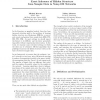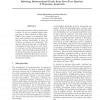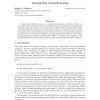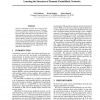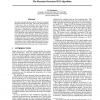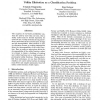106
click to vote
UAI
1998
15 years 2 months ago
1998
We present an anytime algorithm which computes policies for decision problems represented as multi-stage influence diagrams. Our algorithm constructs policies incrementally, start...
109
click to vote
UAI
1998
15 years 2 months ago
1998
We study two-layer belief networks of binary random variables in which the conditional probabilities Pr childjparents depend monotonically on weighted sums of the parents. In larg...
UAI
1998
15 years 2 months ago
1998
120
click to vote
UAI
1998
15 years 2 months ago
1998
People using consumer software applications typically do not use technical jargon when querying an online database of help topics. Rather, they attempt to communicate their goals ...
103
click to vote
UAI
1998
15 years 2 months ago
1998
Causal models defined in terms of a collection of equations, as defined by Pearl, are axiomatized here. Axiomatizations are provided for three successively more general classes of...
120
click to vote
UAI
1998
15 years 2 months ago
1998
tigate the use of temporally abstract actions, or macro-actions, in the solution of Markov decision processes. Unlike current models that combine both primitive actions and macro-...
UAI
1998
15 years 2 months ago
1998
Dynamic probabilistic networks are a compact representation of complex stochastic processes. In this paper we examine how to learn the structure of a DPN from data. We extend stru...
134
click to vote
UAI
1998
15 years 2 months ago
1998
In recent years there has been a flurry of works on learning Bayesian networks from data. One of the hard problems in this area is how to effectively learn the structure of a beli...
102
click to vote
UAI
1998
15 years 2 months ago
1998
The majority of real-world probabilistic systems are used by more than one user, thus a utility model must be elicited separately for each newuser. Utility elicitation is long and...
UAI
1998
15 years 2 months ago
1998

